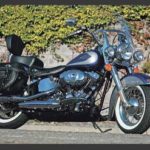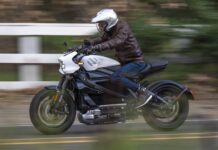History in the remaking
An old favorite gets the once over
Over the course of the two decades following the model’s 1988 debut, the distinctive appearance of the Heritage Classic remained virtually unchanged, resistant to even the incremental styling tweaks that visited all other long-running core models periodically, but to expect otherwise would perhaps be to miss the whole “heritage” point. Still, 21 years is a long time even by Harley’s glacial standards of change—so long, in fact, that by 2008 the model was not only paying homage to the ’50s era FLs it took its principle styling cues from, it was paying homage to itself, celebrating, in effect, the heritage of the Heritage.
For 2009 that’s all changed… sort of. Meaning that while the model has received its first extensive cosmetic makeover in its long tenure, that makeover consists entirely of elements that flesh out even further the original nostalgic objective. The two principle design themes that have characterized the Heritage from the outset are its retro styling and its elaborate ornamentation (featuring copious chrome from bow to stern and studs galore in an exercise in decorative excess outstripped in Harley history only by the late Heritage Springer) and in revisiting the model this year The Motor Company has essentially taken those themes and doubled down on them, resulting in a bike that is decidedly a Heritage—only more so.
Cross breeding the Cross Bones
In that effort, the Heritage got a lot of help from its Softail stablemates, most notably the FLSTSB Cross Bones. With the introduction of that Dark Custom model last year, Harley reached back to the ’40s to retrieve a batch of signature period components including the cat-eye dash, half-moon floorboards and oval brake pedal. Those things find their way over to the new Heritage—the cat-eye getting a chrome-dip treatment along the way—and add to the bike’s vintage credentials handsomely. Also helping out was the FLSTN Softail Deluxe which contributed its ’50s style FL front fender as well as the wide whitewalls shown here and offered as an option. (Why it didn’t also contribute its tombstone taillight is hard to figure, considering, but I suppose they had to leave the Deluxe with some bragging rights.)
On the ornamentation front, the new Heritage is decked out with even more conchos than previously, including one on the back of the sissy bar, and these conchos sport braided leather tassels, giving the bike even more of the chrome-pony Western flair (or “ranch dressing,” if you prefer) it’s known for. The heaping helping of chrome studs that have decorated the model’s immense leather saddlebags all these years have been rearranged into a broad sweep of dazzle across the flanks. Up on the tank console, the Western flair enhancement continues with a new two-piece, two-tone chrome-studded leather swath in place of the plain panel that preceded it. Remaining true to its roots, the machine still looks like it just survived a head-on with a mariachi band—only more so.
At home on the highway
For all of that, the Heritage Classic remains first and foremost an old school bagger, and in that role it excels, proving for the most part as road worthy and distance-friendly as any dedicated touring mount from Milwaukee. As a roots dresser, the bike is devoid of contemporary touring amenities—cruise control, sound system, ABS, GPS, bells and/or whistles—and that’s not a drawback in the least for touring purists who consider a hyper-reliable, torque-pumping 96-inch mill hooked up to a long-legged 6-speed tranny to be, quite simply, the epitome of open road luxury. The expansive windscreen and those enormous saddlebags, with a capacity exceeding the hard bags of the Tourers, are a big part of the Heritage Classic’s touring capability, but not the whole story. A big plush operator saddle, operator floorboards, plush passenger accommodations that include a fat pillion and sissy bar with a thick well-positioned backrest contribute as well, making this machine a creature of all-day comfort.
Ergonomically, the combination of low-slung saddle, wide-spaced floorboards and high handlebars (which grew noticeably for 2009, qualifying now them as true apehangers) place the rider in a posture that is both kicked-back comfortable and go-to-hell cool. Even with its relatively short travel, the Softail rear suspension cushions the ride competently, actually producing a smoother ride than the slammed air suspension of the Tourer platform’s fashion statement, the Street Glide. Slow speed operation and handling in parking lots and around town is pretty much intuitive, the Heritage maneuvering agilely with little effort. It helps in those situations that The Motor Company showed some restraint with the rubber for once and didn’t go all trendy phat-crazy with the size of the rear tire like they’re wont to do these days. It remains a manageable 150/80B16—the skinniest rear tire on a Big Twin with the exception of the 140mm MU85B16 on the Deluxe. The only downside of the Heritage’s handling, in fact, is literally the downside—i.e., its restricted cornering clearance. The addition of the Cross Bones floorboards exacerbated that condition on the 2009 Heritage, and scraping them in the corners is an unavoidable fact of life on this bike. It’s something you quickly learn to anticipate and adjust for when piloting into a curve.
Shape shifting
The Heritage Classic has a lot going for it both mechanically and cosmetically, but perhaps its most attractive trait is its versatility. It’s a bike that can quickly and with little effort be adapted to a variety of riding and profiling purposes. Due to the wild mood swings of this globally-warmed winter, I’ve been occasioned the opportunity to put miles on the Heritage in temperatures ranging from the mid-30s to the low 80s—and that was in a two-week swing. To deal with the chilly end of that range, I installed the electrical pigtail for my heated vest and gloves, an operation that is tedious and tricky on most machines. Not so on the Heritage. With its elegant two-piece seat attachment design, and its upright, unobstructed battery placement underneath, a single flat-blade screwdriver and a few minutes are all that are required to effect the hook-up. It’s also an easy and sanitary matter to thread the pigtail out at the rear of tank for easy access. With the duds plugged in, and the outstanding weather protection afforded by the windscreen, a straight three-hour fuel-stop to fuel-stop run in frosty conditions caused no ill-effects besides numb foot heels (which is a truly weird thing to experience when dismounting at a gas station and hobbling across the pavement like Ratso Rizzo).
At the other temperature extreme, it’s also a simple matter to flick a pair of spring clips and pop the quick-release windscreen off its docking points letting the warm breezes blow. The look of the Heritage changes dramatically with that simple alteration—much more dramatically than you’d have any right to expect—and it’s with the windscreen removed that you fully appreciate the tuff looks of those new apehangers. It’s also with the windscreen removed that you get an unobstructed view of the new restyled headlamp nacelle (though, in truth, I prefer the old one).
With all that versatility and timeless Milwaukee style points going for it, it’s small wonder that the Heritage Classic has remained popular for as long as it has. It was a groundbreaking design when unveiled in 1988, and it’s aged well. There is, in fact, no more familiar a silhouette on the summer highway than that of a couple on a road trip laid back on a Heritage with a stacked-up T-Bag clinging to the sissy bar. Don’t expect that to change. While the bike has undergone a slew of changes for 2009 it continues to be powerfully appealing for all the same reasons it has in the past—maybe even more so.























